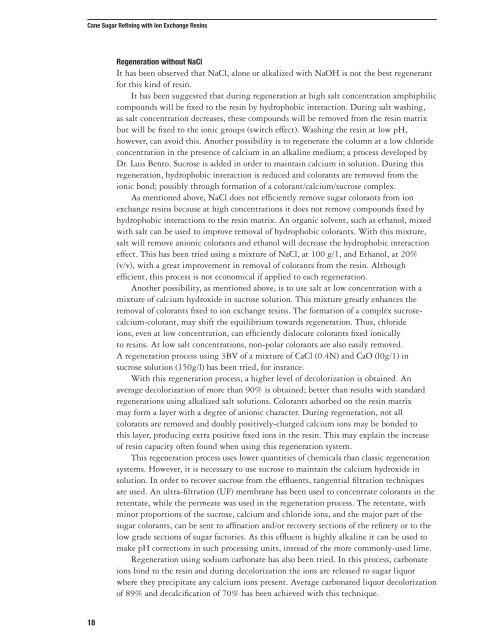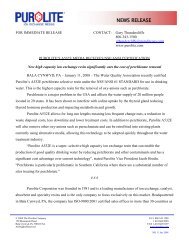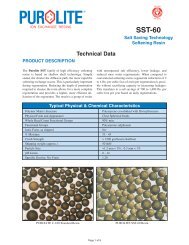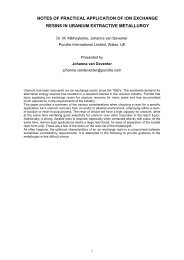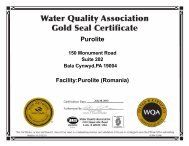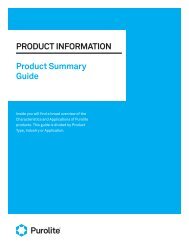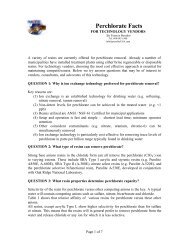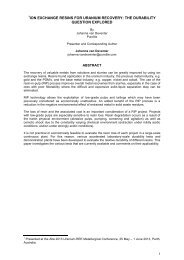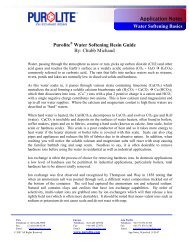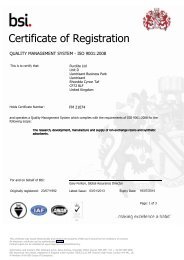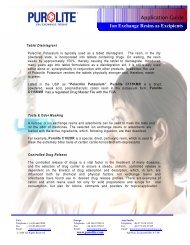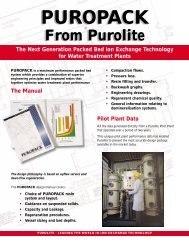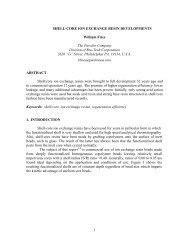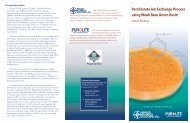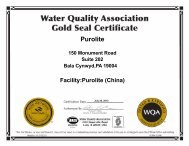Cane Sugar Refining - Purolite
Cane Sugar Refining - Purolite
Cane Sugar Refining - Purolite
You also want an ePaper? Increase the reach of your titles
YUMPU automatically turns print PDFs into web optimized ePapers that Google loves.
<strong>Cane</strong> <strong>Sugar</strong> <strong>Refining</strong> with Ion Exchange Resins<br />
18<br />
Regeneration without NaCl<br />
It has been observed that NaCl, alone or alkalized with NaOH is not the best regenerant<br />
for this kind of resin.<br />
It has been suggested that during regeneration at high salt concentration amphiphilic<br />
compounds will be fixed to the resin by hydrophobic interaction. During salt washing,<br />
as salt concentration decreases, these compounds will be removed from the resin matrix<br />
but will be fixed to the ionic groups (switch effect). Washing the resin at low pH,<br />
however, can avoid this. Another possibility is to regenerate the column at a low chloride<br />
concentration in the presence of calcium in an alkaline medium; a process developed by<br />
Dr. Luis Bento. Sucrose is added in order to maintain calcium in solution. During this<br />
regeneration, hydrophobic interaction is reduced and colorants are removed from the<br />
ionic bond; possibly through formation of a colorant/calcium/sucrose complex.<br />
As mentioned above, NaCl does not efficiently remove sugar colorants from ion<br />
exchange resins because at high concentrations it does not remove compounds fixed by<br />
hydrophobic interactions to the resin matrix. An organic solvent, such as ethanol, mixed<br />
with salt can be used to improve removal of hydrophobic colorants. With this mixture,<br />
salt will remove anionic colorants and ethanol will decrease the hydrophobic interaction<br />
effect. This has been tried using a mixture of NaCl, at 100 g/1, and Ethanol, at 20%<br />
(v/v), with a great improvement in removal of colorants from the resin. Although<br />
efficient, this process is not economical if applied to each regeneration.<br />
Another possibility, as mentioned above, is to use salt at low concentration with a<br />
mixture of calcium hydroxide in sucrose solution. This mixture greatly enhances the<br />
removal of colorants fixed to ion exchange resins. The formation of a complex sucrose-<br />
calcium-colorant, may shift the equilibrium towards regeneration. Thus, chloride<br />
ions, even at low concentration, can efficiently dislocate colorants fixed ionically<br />
to resins. At low salt concentrations, non-polar colorants are also easily removed.<br />
A regeneration process using 3BV of a mixture of CaCl (0.4N) and CaO (l0g/1) in<br />
sucrose solution (150g/l) has been tried, for instance.<br />
With this regeneration process, a higher level of decolorization is obtained. An<br />
average decolorization of more than 90% is obtained; better than results with standard<br />
regenerations using alkalized salt solutions. Colorants adsorbed on the resin matrix<br />
may form a layer with a degree of anionic character. During regeneration, not all<br />
colorants are removed and doubly positively-charged calcium ions may be bonded to<br />
this layer, producing extra positive fixed ions in the resin. This may explain the increase<br />
of resin capacity often found when using this regeneration system.<br />
This regeneration process uses lower quantities of chemicals than classic regeneration<br />
systems. However, it is necessary to use sucrose to maintain the calcium hydroxide in<br />
solution. In order to recover sucrose from the effluents, tangential filtration techniques<br />
are used. An ultra-filtration (UF) membrane has been used to concentrate colorants in the<br />
retentate, while the permeate was used in the regeneration process. The retentate, with<br />
minor proportions of the sucrose, calcium and chloride ions, and the major part of the<br />
sugar colorants, can be sent to affination and/or recovery sections of the refinery or to the<br />
low grade sections of sugar factories. As this effluent is highly alkaline it can be used to<br />
make pH corrections in such processing units, instead of the more commonly-used lime.<br />
Regeneration using sodium carbonate has also been tried. In this process, carbonate<br />
ions bind to the resin and during decolorization the ions are released to sugar liquor<br />
where they precipitate any calcium ions present. Average carbonated liquor decolorization<br />
of 89% and decalcification of 70% has been achieved with this technique.


